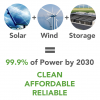Distributed Wind and Solar make the grid more stable
 A new study has determined that renewables could economically fully power a utility scale electric grid 99.9% of the time by 2030 — and without government subsidies, if the proper mix is implemented. This new study affirms what we’ve been saying for a decade now: we don’t need nuclear, coal, oil, gas, biomass/incineration or other dirty energy sources. We can meet our energy needs with conservation, efficiency, wind, solar and energy storage… and it’ll be reliable and cheaper than our status quo. See the press release or the full study.
A new study has determined that renewables could economically fully power a utility scale electric grid 99.9% of the time by 2030 — and without government subsidies, if the proper mix is implemented. This new study affirms what we’ve been saying for a decade now: we don’t need nuclear, coal, oil, gas, biomass/incineration or other dirty energy sources. We can meet our energy needs with conservation, efficiency, wind, solar and energy storage… and it’ll be reliable and cheaper than our status quo. See the press release or the full study.
We need big environmental groups to start accepting that this reality is possible so that they can stop promoting natural gas and biomass as if they are necessary “transition fuels.” One way to help, aside from sharing this info, is to sign onto our platform calling for a 100% shift to clean energy, and encourage others to do the same.
Along the lines of the above study, distributed wind makes a grid more stable:
Mid-Atlantic Offshore Wind Potential: 330 GW “To make wind power more uniform, the study shows that multiple sites could be connected through power lines to reduce the number of times of both maximum and minimum power. Changes in new and replacement energy-using devices, including automobiles, also could provide for greater power storage.”
Fly Wheels for Energy Storage
The nation’s first commercial flywheel energy storage facility went online in upstate New York in 2011: Flywheel energy storage makes 100% wind and solar possible. Another is planned for Hazle Township in northeastern Pennsylvania: Developers to seek approval for Hazle Twp. energy project.
Hydrogen for Energy Storage
Hydrogen is not a fuel, but rather an energy carrier, like a battery. It can be electrolyzed from water with excess electricity, stored in tanks, and called upon to be transformed back into electricity when the demand shifts. Hydrogen is not, however, a very efficient energy carrier. This process is often only about 30% efficient, and should be thought of as a fallback and not a priority.
Hydrogen is NOT, however, suitable for use in vehicles. We would need to build an entire infrastructure around this, when we could use electric vehicles (EV) and plug-in hybrid electric vehicles (PHEV) with the existing infrastructure and with something like 1/3 the electricity hydrogen-powered vehicles would require.
See Hydrogen and Fuel Cells Fact Sheet for more information.

